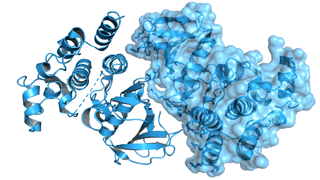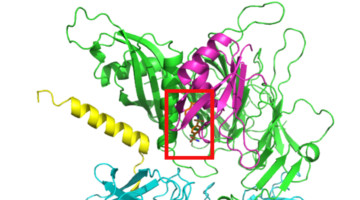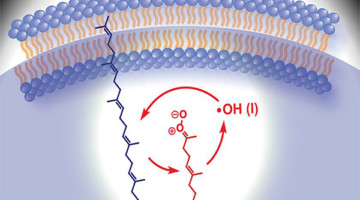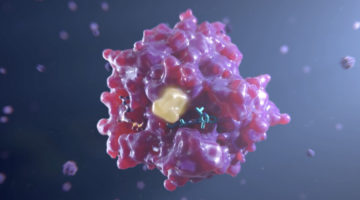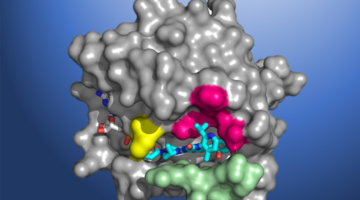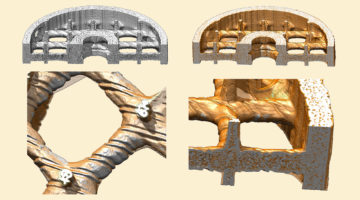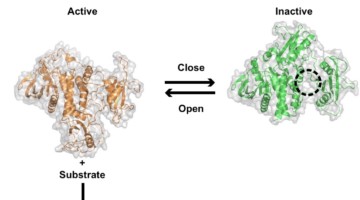To clarify the underlying mechanisms of the FLASH effect, in which the delivery of ultrafast, high-intensity doses of radiation to tumors counterintuitively reduces damage to surrounding healthy cells, researchers directly compared the oxidative effects of conventional and FLASH techniques using x-ray footprinting at the ALS. Read more »
Structures Signal Fresh Targets for Anticancer Drugs
Researchers from Genentech used a suite of methods, including small-angle x-ray scattering, to learn how an assembly of three proteins works together to transmit signals for cell division. The work reveals new targets for the development of drugs that fight certain types of cancer, including lung, colorectal, and pancreatic cancer. Read more »![]()
![]()
This Enigmatic Protein Sculpts DNA to Repair Harmful Damage
Scientists have discovered that a DNA-repairing protein performs its functions by first marking and then further breaking damaged DNA. The surprising findings have provided much-needed insight into how DNA repair works in healthy human cells, as well as how different mutations can translate into different diseases and cancer. Read more »
On-Off Switch for Regulating Tumor-Cell Growth
The mechanisms that affect the regulation of cell growth in certain tumor cells were revealed by a Genentech study of enzyme structures, conducted in part at the ALS. The work establishes a framework for the rational discovery of new therapeutics to improve upon currently existing treatments for certain cancers. Read more »![]()
![]()
How a Cancer Drug Targets Proteins for Degradation
Protein structures obtained by Novartis researchers helped reveal how a cancer drug promotes the degradation of proteins essential to cell proliferation. A detailed understanding of the drug’s mechanism of action is key to determining whether the protein-degradation system can be reprogrammed to degrade different targets. Read more »![]()
Criegee Intermediates Play Unexpected Role in Cell Chemistry
Researchers employed mass spectrometry to illuminate lipid nanodroplets under ultraviolet light. The results unexpectedly showed that hydroxyl radicals cause damage to cells via the formation of Criegee intermediates: molecules first proposed in 1975 to explain how pollutants react with the ozone layer in our atmosphere. Read more »
ALS Reveals Vulnerability in Cancer-Causing Protein
A promising anticancer drug, AMG 510, was developed by Amgen Inc. with the help of novel structural insights gained from protein structures solved at the ALS. AMG 510, which is currently in phase II clinical trials for efficacy, targets tumors caused by mutations in the KRAS protein, one of the most common causes of cancer. Read more »![]()
![]()
Unique Cancer Drug Discovered With Help From Advanced Light Source Begins Historic Clinical Trial
Errors in the KRAS gene, which encodes a crucial cell-signaling protein, are one of the most common causes of cancer. Seeking to develop a long-sought direct inhibitor, researchers at Amgen conducted x-ray crystallography of KRAS(G12C) proteins at the ALS. The high-resolution structural maps helped Amgen make the breakthrough discovery of a small pocket on the molecule. Read more »
Absorber Captures Excess Chemotherapy Drugs
Researchers have designed a biomedical device for absorbing excess chemotherapy drugs during cancer treatment, characterizing the active surface layer using x-ray microtomography. The work opens up a new route to fighting cancer that minimizes drug toxicity and enables personalized, targeted, high-dose chemotherapy. Read more »![]()
![]()
Locking Protein Structure to Close the Door on Cancer
While the SHP2 protein helps regulate cellular activity, mutations in its structure can lead to cancer. X-ray crystallography at the ALS and SSRL has revealed differences between normal and mutated SHP2, as well as how it binds to certain cancer drugs. These structural insights open the door to new types of cancer therapy. Read more »



